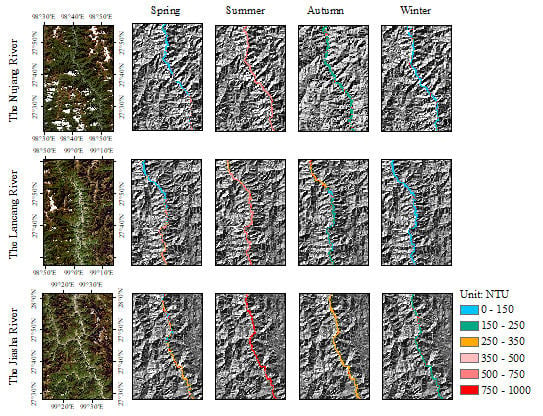Remote Sensing Retrieval of Turbidity in Alpine Rivers based on high Spatial Resolution Satellites
Abstract
:1. Introduction
2. Materials and Methods
2.1. Study Area
2.2. Data Collection
2.2.1. In Situ Measurements
2.2.2. Water Sampling and Laboratory Analysis
2.2.3. Satellite Observation
2.3. Turbidity Model Development
2.4. Accuracy Assessment
3. Results
3.1. Bio-optical Properties of the River Waters
3.2. Spectral Reflectance Properties
3.3. Model Calibration and Validation Using in Situ Data
3.3.1. 2BSAT Model Calibration
3.3.2. 2BSAT Model Validation
3.4. Model Calibration and Validation Using Simulated Sentinel-2 Bands
3.5. Turbidity Retrieval
3.5.1. Satellite-based Versus Simulated
3.5.2. Turbidity Mapping Using Sentinel-2 Images
3.5.3. Long-term Seasonal Turbidity Change from 1989 to 2018
4. Discussion
4.1. Performance of the Four Existing Turbidity Models
4.2. Turbidity Model Evaluation and Comparison
4.3. Factors Affecting River Turbidity
4.3.1. Cascade Hydropower Stations
4.3.2. Sewage Discharge and Road Construction
4.3.3. Precipitation
5. Conclusions
- (1)
- The 2BSAT model was calibrated and validated while using one calibration dataset from the TPR and two independent validation datasets that were obtained from the KDR and YZR, respectively. The study results indicate that the 2BSAT model is reliable and robust in retrieving turbidity in alpine rivers from clear to highly turbid water bodies. Moreover, there is no need to reselect the bands, even though parameter optimization is required for improving the accuracy of the retrieval results.
- (2)
- Based on in situ hyperspectral data, the 2BSAT model produced a superior performance in deriving the TU from alpine rivers in comparison to the Lathrop, Chen, Nechad, and Doxaren models. It was confirmed that the 2BSAT model, in estimating the TU, decreased the uncertainty by 36%, 40%, 48%, and 6% of the MRE values, respectively, from the above 4 models in the TPR.
- (3)
- The 2BSAT model was used to analyze the temporal–spatial variation of TU based on the Sentinel-2 and Landsat series images. In the spatial variations, the five rivers showed different spatial distribution characteristics and the distribution difference of turbidity also existed upstream and downstream of the same river. In the temporal variations, it proved to be a general rule that the highest turbidity in these alpine rivers usually appeared in summer, while the lowest appeared in winter. In addition, the study found that the turbidity of KDR and YZR showed downward trends overall over the past 30 years.
- (4)
- Human activities, such as engineering construction and sewage discharge, have severely affected the water quality of alpine rivers. However, seasonal factors still dominate river turbidity changes from the perspective of long river reaches. For instance, precipitation and turbidity had a consistent seasonal dynamic regularity from 1989 to 2012 and the correlation coefficient between the two reached 0.74.
Author Contributions
Funding
Acknowledgments
Conflicts of Interest
References
- Cloern, J.E. Turbidity as a control on phytoplankton biomass and productivity in estuaries. Cont. Shelf Res. 1987, 7, 1367–1381. [Google Scholar] [CrossRef]
- Fisher, T.R.; Gustafson, A.B.; Sellner, K.; Lacouture, R.; Haas, L.W.; Wetzel, R.L.; Magnien, R.; Everitt, D.; Michaels, B.; Karrh, R.; et al. Spatial and temporal variation of resource limitation in Chesapeake Bay. Mar. Biol. 1999, 133, 763–778. [Google Scholar] [CrossRef]
- Bilotta, G.S.; Brazier, R.E. Understanding the influence of suspended solids on water quality and aquatic biota. Water Res. 2008, 42, 2849–2861. [Google Scholar] [CrossRef] [PubMed]
- Wang, S.Y.; Shen, M.; Ma, Y.X.; Chen, G.S.; You, Y.F.; Liu, W.H. Application of Remote Sensing to Identify and Monitor Seasonal and Interannual Changes of Water Turbidity in Yellow River Estuary, China. J. Geophys. Res. 2019, 124, 4904–4917. [Google Scholar] [CrossRef]
- Su, B.; Ma, Y.; Menenti, M.; Wen, J.; Sobrino, J.; He, Y.; Li, Z.L.; Tang, B.; Sneeuw, N.; Zhong, L.; et al. Concerted Earth Observation and Prediction of Water and Energy Cycles in the Third Pole Environment (CEOP-TPE). In Proceedings of the Dragon 3 Final Results and Dragon 4 Kick-Off, Wuhan, China, 4–8 July 2016. [Google Scholar]
- Zhang, T.; Zhang, Y.; Xu, M.; Zhu, J.; Ning, C.; Jiang, Y.; Ke, H.; Zu, J.; Liu, Y.; Yu, G.; et al. Water availability is more important than temperature in driving the carbon fluxes of an alpine meadow on the Tibetan Plateau. Agric. For. Meteorol. 2018, 256, 22–31. [Google Scholar] [CrossRef]
- Ming, Q.Z.; Shi, Z.T.; Zhang, H.C. The Evolution of the Landform and Environment in the Region of the Three Parallel Rivers. Trop. Geogr. 2006, 5, 119–122. [Google Scholar]
- Gholizadeh, M.H.; Melesse, A.M.; Reddi, L. A comprehensive review on water quality parameters estimation using remote sensing techniques. Sensors 2016, 16, 1298. [Google Scholar] [CrossRef] [Green Version]
- Koponen, S.; Attila, J.; Pulliainen, J.; Kallio, K.; Pyhalahti, T.; Lindfors, A.; Rasmus, K.; Hallikainen, M. A case study of airborne and satellite remote sensing of a spring bloom event in the Gulf of Finland. Cont. Shelf Res. 2007, 27, 228–244. [Google Scholar] [CrossRef]
- Le, C.; Hu, C.; Cannizzaro, J.; English, D.; Muller-Karger, F.; Lee, Z. Evaluation of chlorophyll-a remote sensing algorithm for an optically complex estuary. Remote Sens. Environ. 2013, 129, 75–89. [Google Scholar] [CrossRef]
- Tassan, S. Local algorithms using SeaWiFS data for the retrieval of phytoplankton, pigments, suspended sediment, and yellow substance in coastal waters. Appl. Opt. 1994, 33, 2369–2378. [Google Scholar] [CrossRef]
- Nechad, B.; Ruddick, K.; Park, Y. Calibration and validation of a generic multisensor algorithm for mapping of total suspended matter in turbid waters. Remote Sens. Environ. 2010, 114, 854–866. [Google Scholar] [CrossRef]
- Chen, J.; Quan, W.; Cui, T.; Song, Q. Estimation of total suspended matter concentration from MODIS data using a neural network model in the China eastern coastal zone. Estuar. Coast. Shelf Sci. 2015, 155, 104–113. [Google Scholar] [CrossRef]
- Qiu, Z. A simple optical model to estimate suspended particulate matter in Yellow River Estuary. Opt. Express 2013, 21, 27891–27904. [Google Scholar] [CrossRef] [PubMed]
- Nechad, B.; Ruddick, K.G.; Neukermans, G. Calibration and validation of a generic multisensor algorithm for mapping of turbidity in coastal waters. In Proceedings of the International Society for Optical Engineering (SPIE 2009), San Diego, CA, USA, 2–6 August 2009. [Google Scholar]
- Chen, J.; Cui, T.; Qiu, Z.; Lin, C. A three-band semi-analytical model for deriving total suspended sediment concentration from HJ-1A/CCD data in turbid coastal waters. ISPRS-J. Photogramm. Remote Sens. 2014, 93, 1–13. [Google Scholar] [CrossRef]
- Kuhn, C.; Aline, D.M.; Ward, N.; Loken, L.; Sawakuchi, H.O.; Kampel, M.; Richey, J.; Stadler, P.; Crawford, J.; Striegl, R.; et al. Performance of Landsat-8 and Sentinel-2 surface reflectance products for river remote sensing retrievals of chlorophyll-a and turbidity. Remote Sens. Environ. 2019, 224, 104–118. [Google Scholar] [CrossRef] [Green Version]
- Güttler, F.N.; Niculescu, S.; Gohin, F. Turbidity retrieval and monitoring of Danube Delta waters using multi-sensor optical remote sensing data: An integrated view from the delta plain lakes to the western–northwestern Black Sea coastal zone. Remote Sens. Environ. 2013, 132, 86–101. [Google Scholar] [CrossRef] [Green Version]
- Lopes, V.A.; Fan, F.M.; Pontes, P.R.; Siqueira, V.A.; Collischonn, W.; da Motta Marques, D. A first integrated modelling of a river-lagoon large-scale hydrological system for forecasting purposes. J. Hydrol. 2018, 565, 177–196. [Google Scholar] [CrossRef]
- Mobley, C.D. Radiative Transfer in Natural Waters, 1st ed.; Wuhan University Press: Wuhan, China, 2009; ISBN 978-730-707-355-5. [Google Scholar]
- Volpe, V.; Silvestri, S.; Marani, M. Remote sensing retrieval of suspended sediment concentration in shallow waters. Remote Sens. Environ. 2011, 115, 44–54. [Google Scholar] [CrossRef]
- Gordon, H.R.; Brown, O.B.; Evans, R.H.; Brown, J.W.; Smith, R.C.; Baker, K.S.; Clark, D.K. A semianalytic radiance model of ocean color. J. Geophys. Res. Atmos. 1988, 93, 10909–10924. [Google Scholar] [CrossRef]
- Zhongping, L.; Carder, K.L.; Keping, D. Effects of molecular and particle scatterings on the model parameter for remote-sensing reflectance. Appl. Opt. 2004, 43, 4957–4964. [Google Scholar]
- Shen, F.; Verhoef, W.; Zhou, Y.; Salama, M.S.; Liu, X. Satellite estimates of wide-range suspended sediment concentrations in Changjiang (Yangtze) estuary using MERIS data. Estuaries Coasts 2010, 33, 1420–1429. [Google Scholar] [CrossRef]
- Salama, M.S.; Verhoef, W. Two-stream remote sensing model for water quality mapping: 2SeaColor. Remote Sens. Environ. 2015, 157, 111–122. [Google Scholar] [CrossRef] [Green Version]
- Rügner, H.; Schwientek, M.; Beckingham, B.; Kuch, B.; Grathwohl, P. Turbidity as a proxy for total suspended solids (TSS) and particle facilitated pollutant transport in catchments. Environ. Earth Sci. 2013, 69, 373–380. [Google Scholar] [CrossRef]
- Katlann, R.; Nechad, B.; Ruddick, K.; Zargouni, F. Optical remote sensing of turbidity and total suspended matter in the Gulf of Gabes. Arab. J. Geosci. 2013, 6, 1527–1535. [Google Scholar] [CrossRef]
- Loisel, H.; Mangin, A.; Vantrepotte, V.; Dessailly, D.; Dinh, D.N.; Garnesson, P.; Ouillon, S.; Lefebvre, J.P.; Mériaux, X.; Phan, T.M.; et al. Variability of suspended particulate matter concentration in coastal waters under the Mekong’s influence from ocean color (MERIS) remote sensing over the last decade. Remote Sens. Environ. 2014, 150, 218–230. [Google Scholar] [CrossRef]
- Chen, J.; Quan, W.; Yao, G.; Cui, T. Retrieval of absorption and backscattering coefficients from HJ-1A/CCD imagery in coastal waters. Opt. Express 2013, 21, 5803–5821. [Google Scholar] [CrossRef]
- Gohin, F.; Stanev, E. Annual cycles of chlorophyll-a, non-algal suspended particulate matter, and turbidity observed from space and in-situ in coastal waters. Ocean Sci. 2011, 7, 705–732. [Google Scholar] [CrossRef] [Green Version]
- Luo, Y.; Doxaran, D.; Ruddick, K.; Shen, F.; Gentili, B.; Yan, L.W.; Huang, H.J. Saturation of water reflectance in extremely turbid media based on field measurements, satellite data and bio-optical modelling. Opt. Express 2018, 26, 10435–10451. [Google Scholar] [CrossRef] [Green Version]
- Le, C.; Li, Y.; Zha, Y.; Sun, D.; Huang, C.; Lu, H. A four-band semi-analytical model for estimating chlorophyll a in highly turbid lakes: The case of Taihu Lake, China. Remote Sens. Environ. 2009, 113, 1175–1182. [Google Scholar] [CrossRef]
- Holm-Hansen, O.; Riemann, B. Chlorophyll a Determination: Improvements in Methodology. Oikos 1978, 30, 438–447. [Google Scholar] [CrossRef]
- Drusch, M.; Bello, U.D.; Carlier, S.; Colin, O.; Fernandez, V.; Gascon, F.; Hoersch, B.; Isola, C.; Laberinti, P.; Martimort, P.; et al. Sentinel-2: ESA’s Optical High-Resolution Mission for GMES Operational Services. Remote Sens. Environ. 2012, 120, 25–36. [Google Scholar] [CrossRef]
- The European Space Agency (ESA) Sentinel Online User Guides. Available online: https://earth.esa.int/web/sentinel/user-guides/sentinel-2-msi/document-library/-/asset_publisher/Wk0TKajiISaR/content.html (accessed on 24 October 2019).
- Lee, Z.; Carder, K.L.; Hawes, S.K.; Steward, R.G.; Peacock, T.G.; Davis, C.O. Model for the interpretation of hyperspectral remote-sensing reflectance. Appl. Opt. 1994, 33, 5721–5732. [Google Scholar] [CrossRef] [PubMed] [Green Version]
- Dall’Olmo, G.; Gitelson, A.A. Effect of bio-optical parameter variability on the remote estimation of chlorophyll-a concentration in turbid productive waters: Experimental results. Appl. Opt. 2005, 44, 412–422. [Google Scholar] [CrossRef] [PubMed] [Green Version]
- Dogliotti, A.I.; Ruddick, K.G.; Nechad, B.; Doxaran, D.; Knaeps, E. A single algorithm to retrieve turbidity from remotely-sensed data in all coastal and estuarine waters. Remote Sens. Environ. 2015, 156, 157–168. [Google Scholar] [CrossRef] [Green Version]
- Zimba, P.V.; Gitelson, A. Remote estimation of chlorophyll concentration in hyper-eutrophic aquatic systems: Model tuning and accuracy optimization. Aquaculture 2006, 256, 272–286. [Google Scholar] [CrossRef]
- Gurlin, D.; Gitelson, A.A.; Moses, W.J. Remote estimation of chl-a concentration in turbid productive waters—Return to a simple two-band NIR-red model? Remote Sens. Environ. 2011, 115, 3479–3490. [Google Scholar] [CrossRef]
- Gilerson, A.A.; Gitelson, A.A.; Zhou, J.; Gurlin, D.; Moses, W.; Ioannou, I.; Ahmed, S.A. Algorithms for remote estimation of chlorophyll-a in coastal and inland waters using red and near infrared bands. Opt. Express 2010, 18, 24109–24125. [Google Scholar] [CrossRef] [Green Version]
- Roesler, C.S.; Perry, M.J. Modeling in Situ Phytoplankton Absorption Spectra from Spectral Reflectance: Effects of Spectral Backscatter, 1st ed.; Springer: Boston, MA, USA, 1992; ISBN 978-148-990-762-2. [Google Scholar]
- Bricaud, A.; Morel, A.; Prieur, L. Absorption by Dissolved Organic Matter of the Sea (Yellow Substance) in the UV and Visible Domains. Limnol. Oceanogr. 1981, 26, 43–53. [Google Scholar] [CrossRef]
- Binding, C.E.; Greenberg, T.A.; Bukata, R.P. The MERIS Maximum Chlorophyll Index; its merits and limitations for inland water algal bloom monitoring. J. Gt. Lakes Res. 2013, 39, 100–107. [Google Scholar] [CrossRef]
- Wu, G.; Cui, L.; Duan, H.; Fei, T.; Liu, Y. Specific absorption and backscattering coefficients of the main water constituents in Poyang Lake, China. Environ. Monit. Assess. 2013, 185, 4191–4206. [Google Scholar] [CrossRef]
- Gons, H.J. Optical teledetection of chlorophyll a in turbid inland waters. Environ. Sci. Technol. 1999, 33, 1127–1132. [Google Scholar] [CrossRef]
- Smith, R.C.; Baker, K.S. Optical properties of the clearest natural waters (200-800 nm). Appl. Opt. 1981, 20, 177–184. [Google Scholar] [CrossRef] [PubMed]
- Chinese Standards for Drinking Water Quality. Available online: http://www.nhc.gov.cn/wjw/pgw/201212/33644.shtml (accessed on 27 October 2019).
- Hestir, E.L.; Brando, V.; Campbell, G.; Dekker, A.; Malthus, T. The relationship between dissolved organic matter absorption and dissolved organic carbon in reservoirs along a temperate to tropical gradient. Remote Sens. Environ. 2015, 156, 395–402. [Google Scholar] [CrossRef]
- Nechad, B.; Ruddick, K.; Schroeder, T.; Oubelkheir, K.; Blondeau-Patissier, D.; Cherukuru, N.; Brando, V.; Dekker, A.; Clementson, L.; Banks, A.C.; et al. CoastColour Round Robin datasets: A database to evaluate the performance of algorithms for the retrieval of water quality parameters in coastal waters. Earth Syst. Sci. Data 2015, 8, 173–258. [Google Scholar] [CrossRef] [Green Version]
- Gitelson, A.A.; Gurlin, D.; Moses, W.J.; Barrow, T. A bio-optical algorithm for the remote estimation of the chlorophyll-a concentration in case 2 waters. Environ. Res. Lett. 2009, 4, 045003. [Google Scholar] [CrossRef]
- Matsushita, B.; Wei, Y.; Yu, G.; Oyama, Y.; Yoshimura, K.; Fukushima, T. A hybrid algorithm for estimating the chlorophyll-a concentration across different trophic states in Asian inland waters. ISPRS-J. Photogramm. Remote Sens. 2015, 102, 28–37. [Google Scholar] [CrossRef] [Green Version]
- Du, C.; Wang, Q.; Li, Y.; Lyu, H.; Zhu, L.; Zheng, Z.; Wen, S.; Liu, G.; Guo, Y. Estimation of total phosphorus concentration using a water classification method in inland water. Int. J. Appl. Earth Obs. Geoinf. 2018, 71, 29–42. [Google Scholar] [CrossRef]
- Gilerson, A.; Zhou, J.; Hlaing, S.; Ioannou, I.; Schalles, J.; Gross, B.; Moshary, F.; Ahmed, S. Fluorescence component in the reflectance spectra from coastal waters. Dependence on water composition. Opt. Express 2007, 15, 15702–15721. [Google Scholar] [CrossRef]
- Gitelson, A.; Merzlyak, M.N. Spectral Reflectance Changes Associated with Autumn Senescence of Aesculus hippocastanum L. and Acer platanoides L. Leaves. Spectral Features and Relation to Chlorophyll Estimation. J. Plant Physiol. 1994, 143, 286–292. [Google Scholar] [CrossRef]
- Palmer, S.C.; Hunter, P.D.; Lankester, T.; Hubbard, S.; Spyrakos, E.; Tyler, A.N.; Présing, M.; Horváth, H.; Lamb, A.; Balzter, H.; et al. Validation of Envisat MERIS algorithms for chlorophyll retrieval in a large, turbid and optically-complex shallow lake. Remote Sens. Environ. 2015, 157, 158–169. [Google Scholar] [CrossRef] [Green Version]
- Bailey, S.W.; Werdell, P.J. A multi-sensor approach for the on-orbit validation of ocean color satellite data products. Remote Sens. Environ. 2006, 102, 12–23. [Google Scholar] [CrossRef]
- Pahlevan, N.; Chittimalli, S.K.; Balasubramanian, S.V.; Vellucci, V. Sentinel-2/Landsat-8 product consistency and implications for monitoring aquatic systems. Remote Sens. Environ. 2019, 220, 19–29. [Google Scholar] [CrossRef]
- Lathrop, R.G.; Lillesand, T.M.; Yandell, B.S. Testing the utility of simple multi-date Thematic Mapper calibration algorithms for monitoring turbid inland waters. Int. J. Remote Sens. 1991, 12, 2045–2063. [Google Scholar] [CrossRef]
- Doxaran, D.; Cherukuru, R.C.; Lavender, S.J. Use of reflectance band ratios to estimate suspended and dissolved matter concentrations in estuarine waters. Int. J. Remote Sens. 2005, 26, 1763–1769. [Google Scholar] [CrossRef]
- Gitelson, A.A.; Dall’Olmo, G.; Moses, W.; Rundquist, D.C.; Barrow, T.; Fisher, T.R.; Gurlin, D.; Holz, J. A simple semi-analytical model for remote estimation of chlorophyll-a in turbid waters: Validation. Remote Sens. Environ. 2008, 112, 3582–3593. [Google Scholar] [CrossRef]
- Bowers, D.G.; Binding, C.E. The optical properties of mineral suspended particles: A review and synthesis. Estuar. Coast. Shelf Sci. 2006, 67, 219–230. [Google Scholar] [CrossRef]
- Wu, F.; Xuan, W.; Cai, Y.; Li, C. Spatiotemporal analysis of precipitation trends under climate change in the upper reach of Mekong River basin. Quat. Int. 2016, 392, 137–146. [Google Scholar] [CrossRef] [Green Version]
- Dong, Z.R. Ecological impacts of hydropower development on the Nujiang River, China. Acta Ecol. Sin. 2005, 26, 1591–1596. [Google Scholar]
- Gong, L.; Li, J.; Yang, Q.; Wang, S.; Ma, B.; Peng, Y. Biomass characteristics and simultaneous nitrification–denitrification under long sludge retention time in an integrated reactor treating rural domestic sewage. Bioresour. Technol. 2012, 119, 277–284. [Google Scholar] [CrossRef]




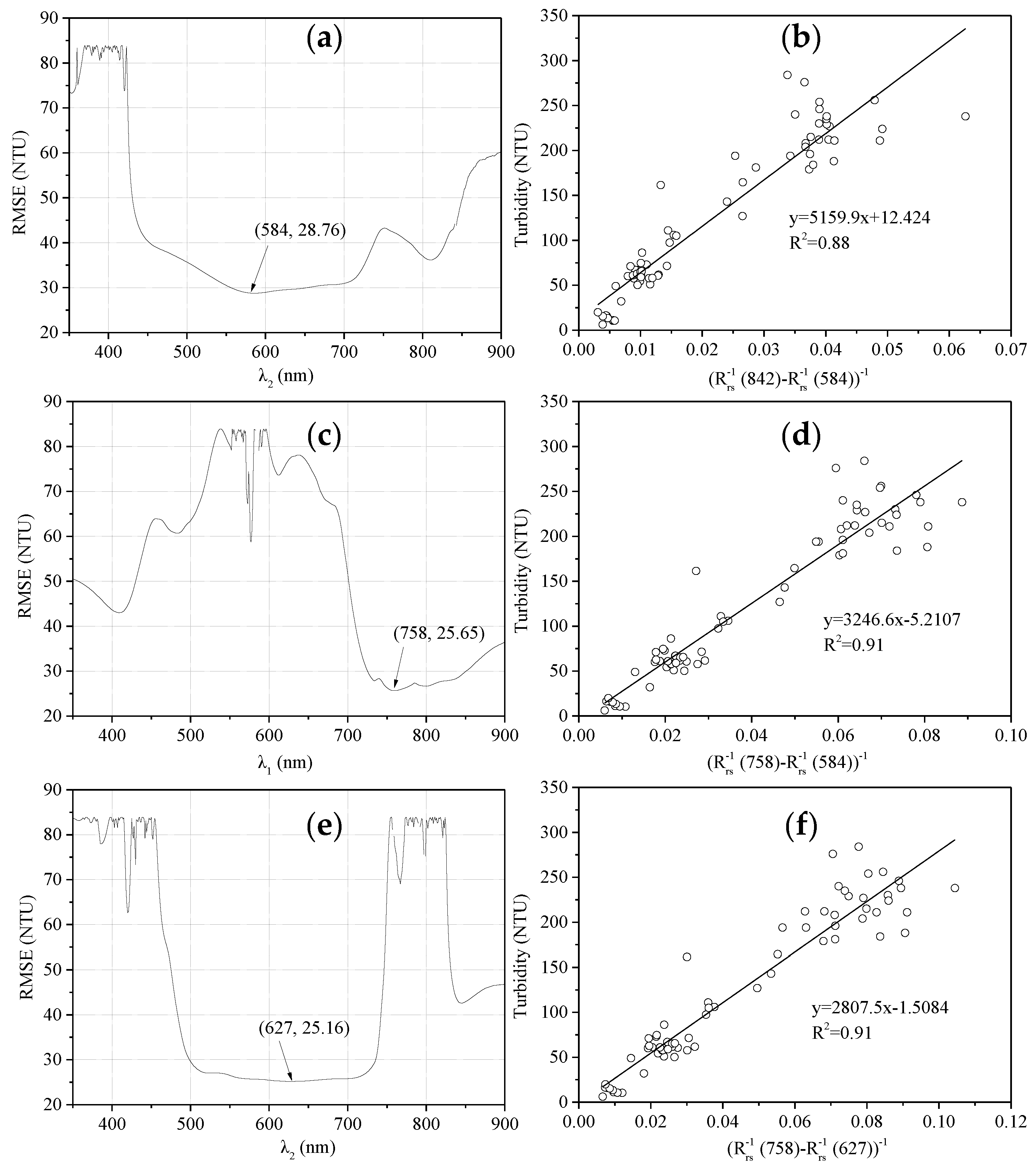

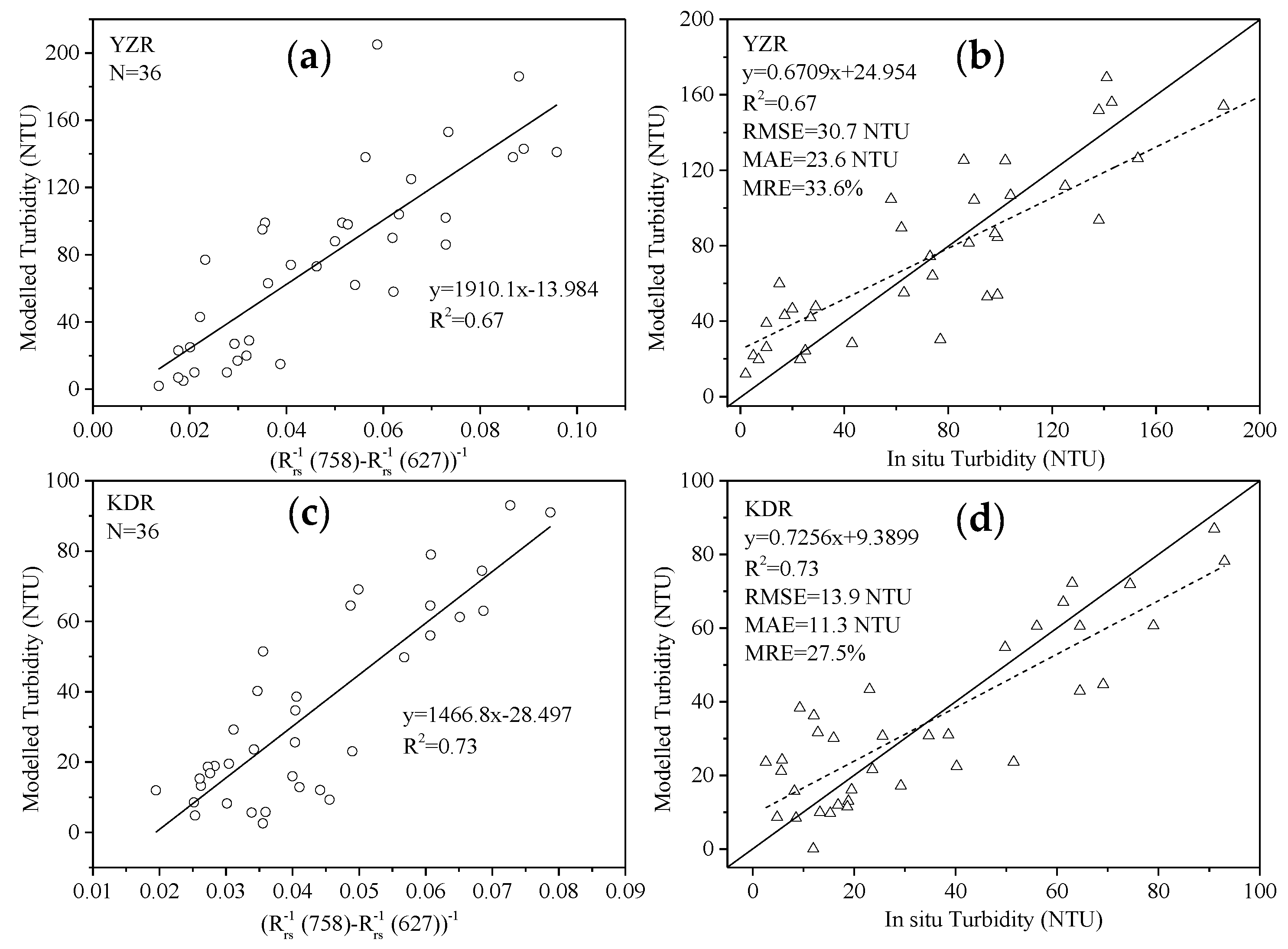
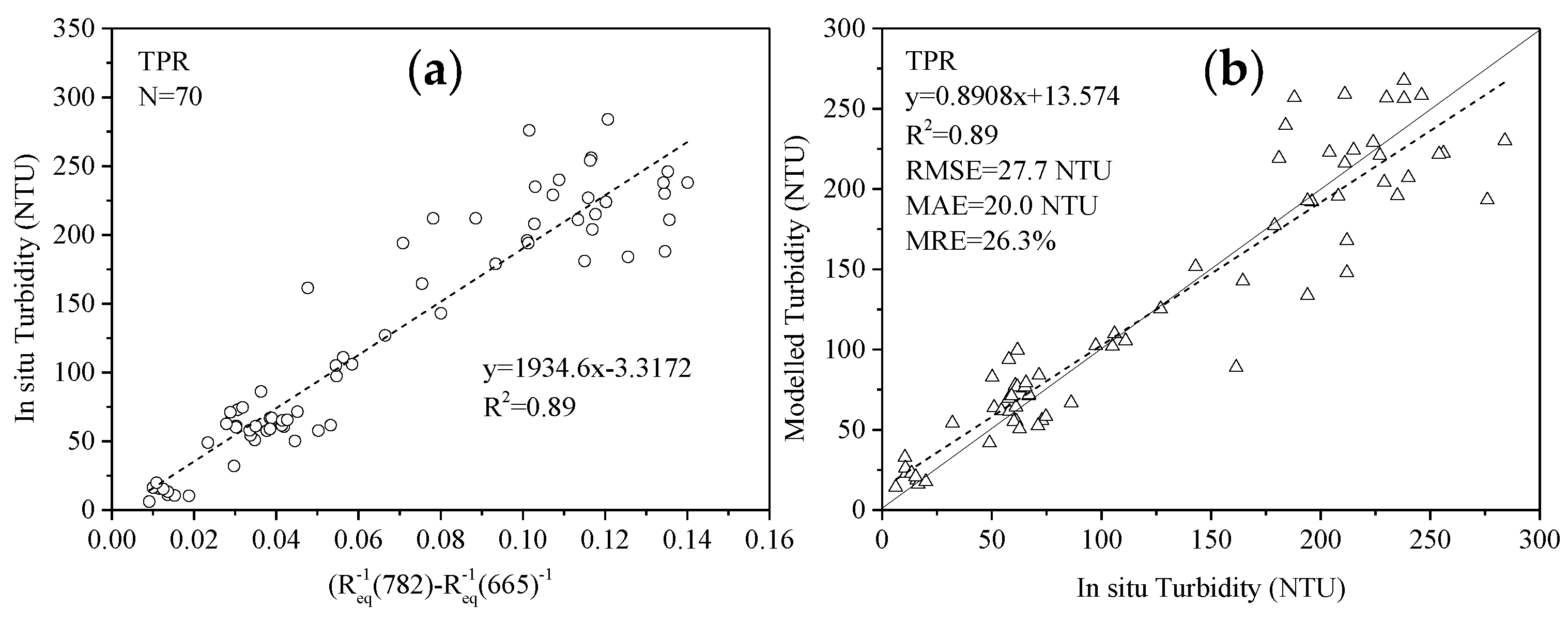



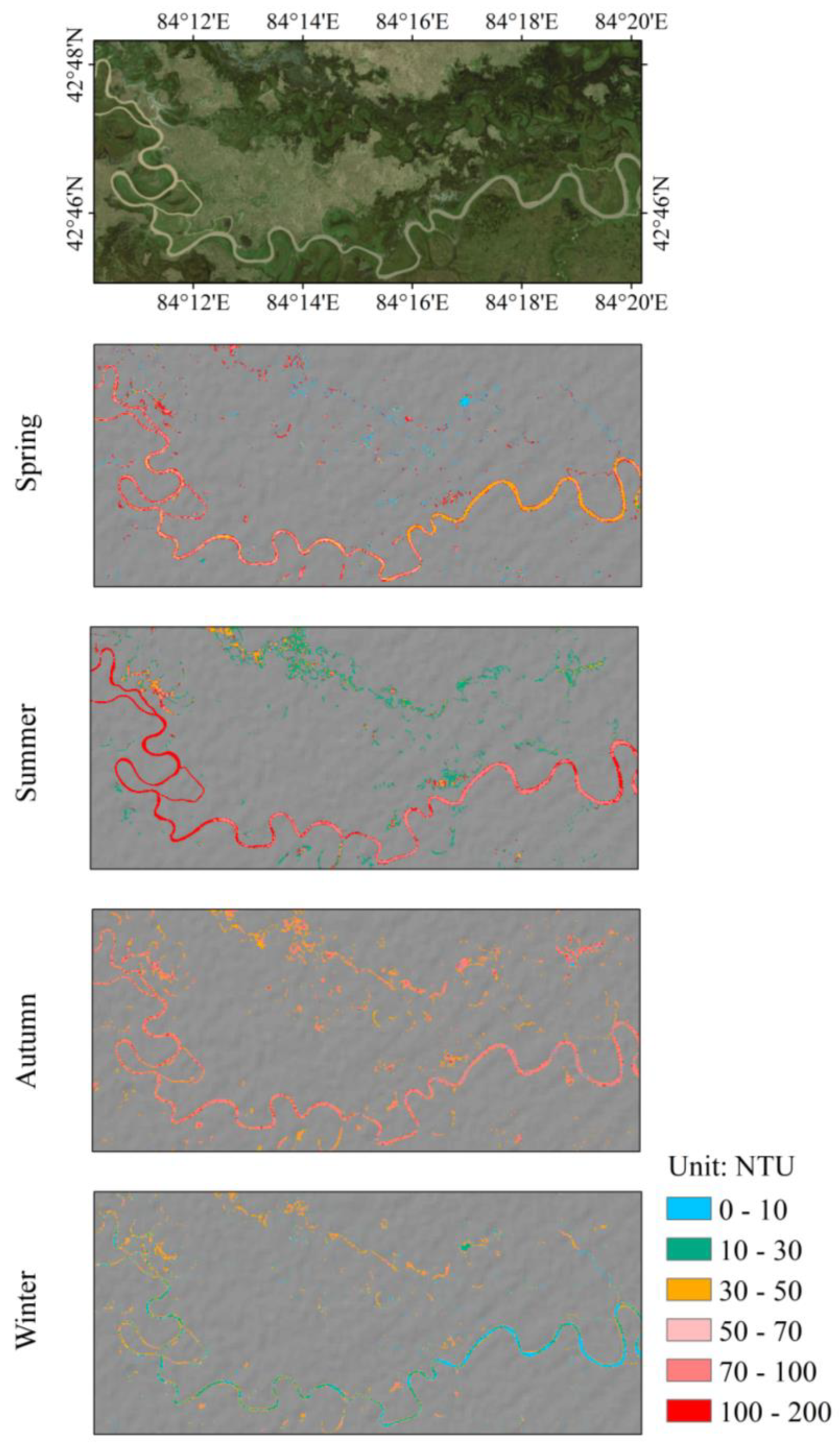

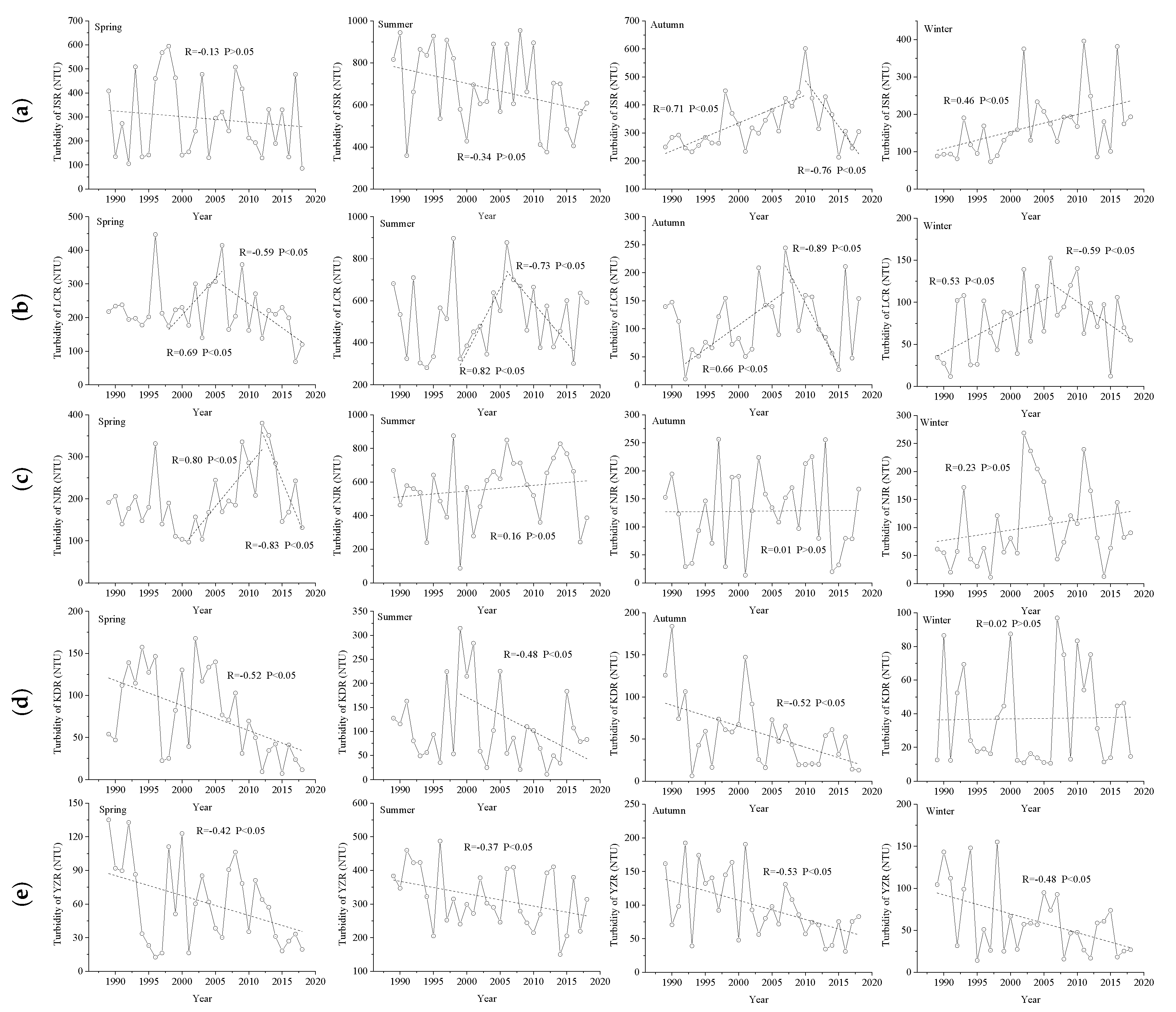

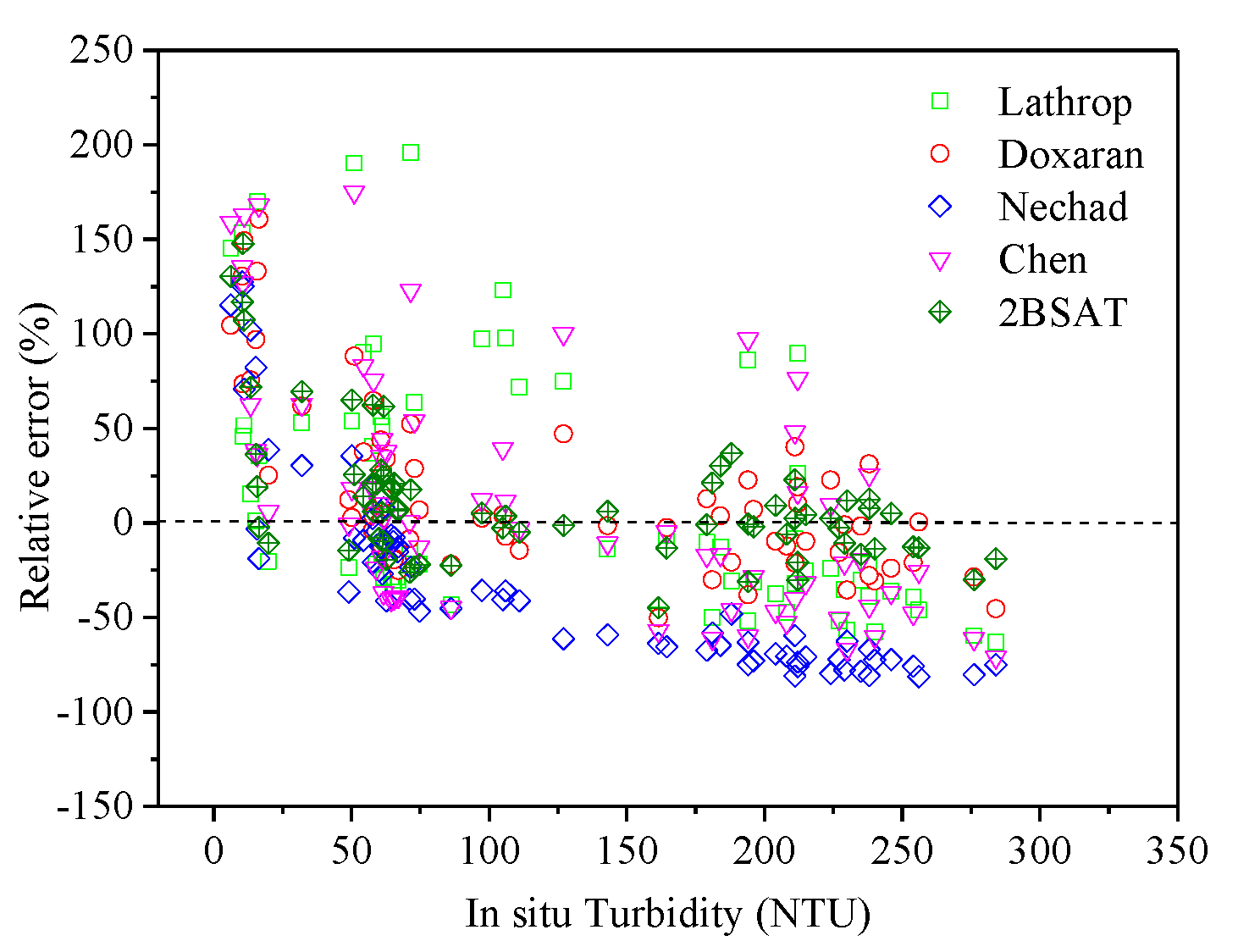

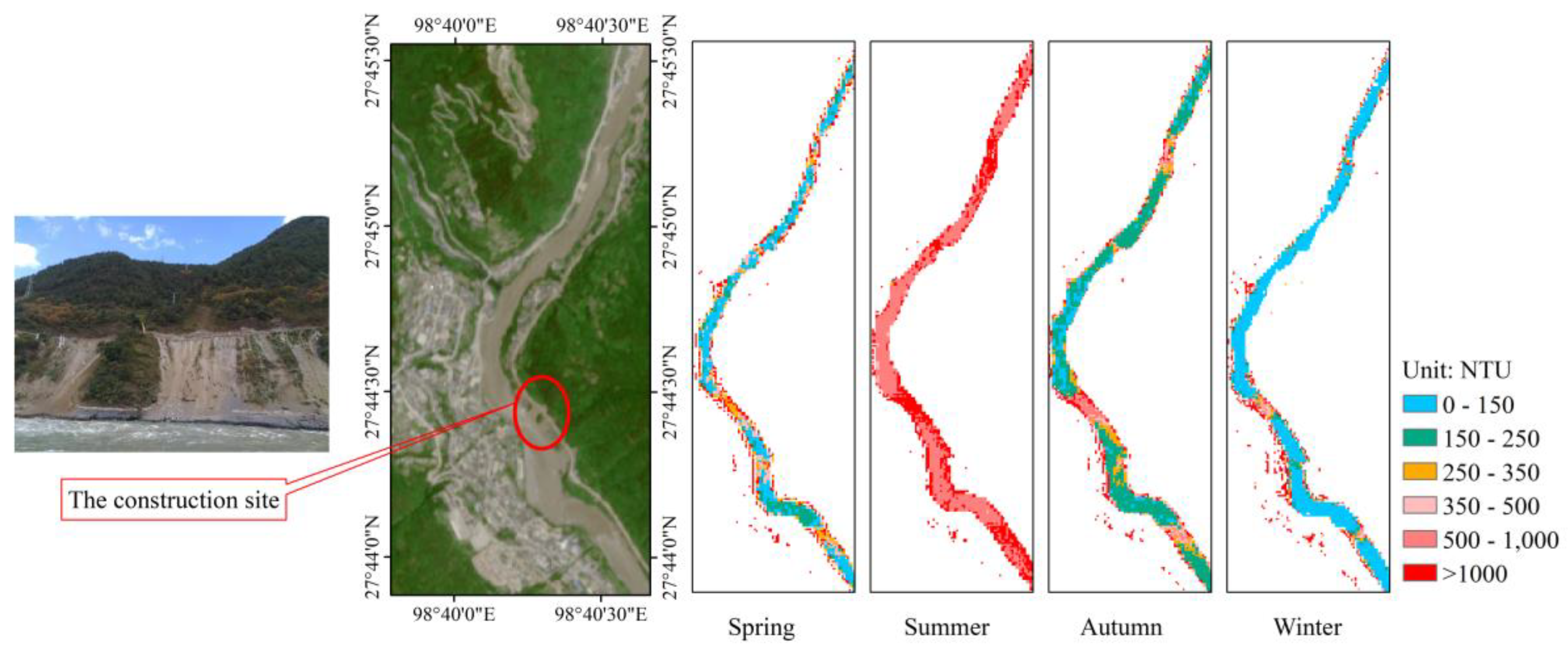


| Band | Central Wavelength (nm) | Band Range (nm) | GSD 1 (m) |
|---|---|---|---|
| B1-Coastal aerosol | 443 | 430–457 | 60 |
| B2-Blue | 490 | 440–538 | 10 |
| B3-Green | 560 | 537–582 | 10 |
| B4-Red | 665 | 646–684 | 10 |
| B5-Vegetation Red Edge | 705 | 694–713 | 20 |
| B6-Vegetation Red Edge | 740 | 731–749 | 20 |
| B7-Vegetation Red Edge | 783 | 769–797 | 20 |
| B8-NIR | 842 | 760–908 | 10 |
| B8A-Narrow NIR | 865 | 848–881 | 20 |
| B9-Water Vapor | 945 | 932–958 | 60 |
| B10-SWIR-Cirrus | 1375 | 1337–1412 | 60 |
| B11-SWIR | 1610 | 1539–1682 | 20 |
| B12-SWIR | 2190 | 2078–2320 | 20 |
| Landasat-8 OLI | Landasat-7 ETM+ | Landasat-5 TM | ||||||
|---|---|---|---|---|---|---|---|---|
| Band | Range (nm) | GSD (m) | Band | Range (nm) | GSD (m) | Band | Range (nm) | GSD (m) |
| B1-Coastal | 433–453 | 30 | ||||||
| B2-Blue | 450–515 | 30 | B1-Blue | 450–525 | 30 | B1-Blue | 450–520 | 30 |
| B3-Green | 525–660 | 30 | B2-Green | 525–605 | 30 | B2-Green | 520–600 | 30 |
| B4-Red | 630–680 | 30 | B3-Red | 630–690 | 30 | B3-Red | 630–690 | 30 |
| B5-NIR | 845–885 | 30 | B4-NIR | 750–900 | 30 | B4-NIR | 760–900 | 30 |
| B6-SWIR1 | 1560–1660 | 30 | B5-SWIR | 1550–1750 | 30 | B5-SWIR | 1550–1750 | 30 |
| B7-SWIR2 | 2100–2300 | 30 | B6-LWIR | 10,400–12,500 | 60 | B6-LWIR | 10,400–12,500 | 120 |
| B8-Pan | 500–680 | 15 | B7-SWIR | 2090–2350 | 30 | B7-SWIR | 2080–2350 | 30 |
| B9-Cirrus | 1360–1390 | 30 | B8-Pan | 520–900 | 15 | |||
| TPR | KDR | YZR | ||||
|---|---|---|---|---|---|---|
| Path/Row | Number | Path/Row | Number | Path/Row | Number | |
| Sentinel-2A/B (2018.9–2019.8) | T47/RMM, T47/RNM, T47/RML, T47/RNL, T47/RMK, T47/RNK, T47/RMJ, T47/RNJ | 106 | T44/TQN | 45 | T46/RBT, T46/RCT | 64 |
| Landsat-5/7/8 (1989–2018) | 132/41, 132/42 | 418 | 144/30, 145/30 | 372 | 138/40 | 335 |
| River | Parameter | Min | Max | Mean | Std | CV | Number |
|---|---|---|---|---|---|---|---|
| YZR | TU(NTU) | 2.00 | 205.00 | 73.48 | 54.06 | 0.74 | 40 |
| TOC(mg L−1) | 0.61 | 3.82 | 1.33 | 0.55 | 0.41 | 40 | |
| KDR | Chl-a(mg m−3) | 2.53 | 8.72 | 4.29 | 1.65 | 0.39 | 38 |
| TU(NTU) | 1.01 | 75.28 | 25.77 | 24.84 | 0.96 | 38 | |
| TOC(mg L−1) | 0.80 | 30.13 | 8.63 | 7.63 | 0.88 | 38 | |
| JSR | TU(NTU) | 9.59 | 284.00 | 208.19 | 49.90 | 0.24 | 30 |
| TOC(mg L−1) | 2.01 | 4.28 | 3.84 | 0.44 | 0.11 | 30 | |
| DOC(mg L−1) | 1.97 | 4.08 | 3.59 | 0.35 | 0.10 | 30 | |
| LCR | TU(NTU) | 1.64 | 161.50 | 51.32 | 39.04 | 0.76 | 28 |
| TOC(mg L−1) | 3.67 | 4.34 | 3.97 | 0.17 | 0.04 | 28 | |
| DOC(mg L−1) | 2.82 | 3.95 | 3.57 | 0.22 | 0.06 | 28 | |
| NJR | TU(NTU) | 59.00 | 86.20 | 67.15 | 7.09 | 0.11 | 12 |
| TOC(mg L−1) | 3.37 | 4.07 | 3.61 | 0.22 | 0.06 | 12 | |
| DOC(mg L−1) | 2.79 | 3.13 | 2.96 | 0.09 | 0.03 | 12 |
| Spring | Summer | Autumn | Winter | |
|---|---|---|---|---|
| NJR | 124.8 | 548.7 | 196.3 | 83.5 |
| LCR | 234.1 | 524.8 | 174.4 | 56.7 |
| JSR | 265.2 | 779.5 | 292.3 | 182.4 |
| Spring | Summer | Autumn | Winter | |
|---|---|---|---|---|
| JSR | 293.3 | 677.2 | 329.3 | 169.7 |
| LCR | 224.3 | 520.6 | 110.5 | 76.7 |
| NJR | 199.2 | 558.0 | 128.1 | 102.1 |
| KDR | 77.5 | 106.9 | 56.3 | 37.1 |
| YZR | 61.3 | 317.9 | 97.1 | 61.8 |
© 2019 by the authors. Licensee MDPI, Basel, Switzerland. This article is an open access article distributed under the terms and conditions of the Creative Commons Attribution (CC BY) license (http://creativecommons.org/licenses/by/4.0/).
Share and Cite
Liu, W.; Wang, S.; Yang, R.; Ma, Y.; Shen, M.; You, Y.; Hai, K.; Baqa, M.F. Remote Sensing Retrieval of Turbidity in Alpine Rivers based on high Spatial Resolution Satellites. Remote Sens. 2019, 11, 3010. https://doi.org/10.3390/rs11243010
Liu W, Wang S, Yang R, Ma Y, Shen M, You Y, Hai K, Baqa MF. Remote Sensing Retrieval of Turbidity in Alpine Rivers based on high Spatial Resolution Satellites. Remote Sensing. 2019; 11(24):3010. https://doi.org/10.3390/rs11243010
Chicago/Turabian StyleLiu, Weihua, Siyuan Wang, Ruixia Yang, Yuanxu Ma, Ming Shen, Yongfa You, Kai Hai, and Muhammad Fahad Baqa. 2019. "Remote Sensing Retrieval of Turbidity in Alpine Rivers based on high Spatial Resolution Satellites" Remote Sensing 11, no. 24: 3010. https://doi.org/10.3390/rs11243010




